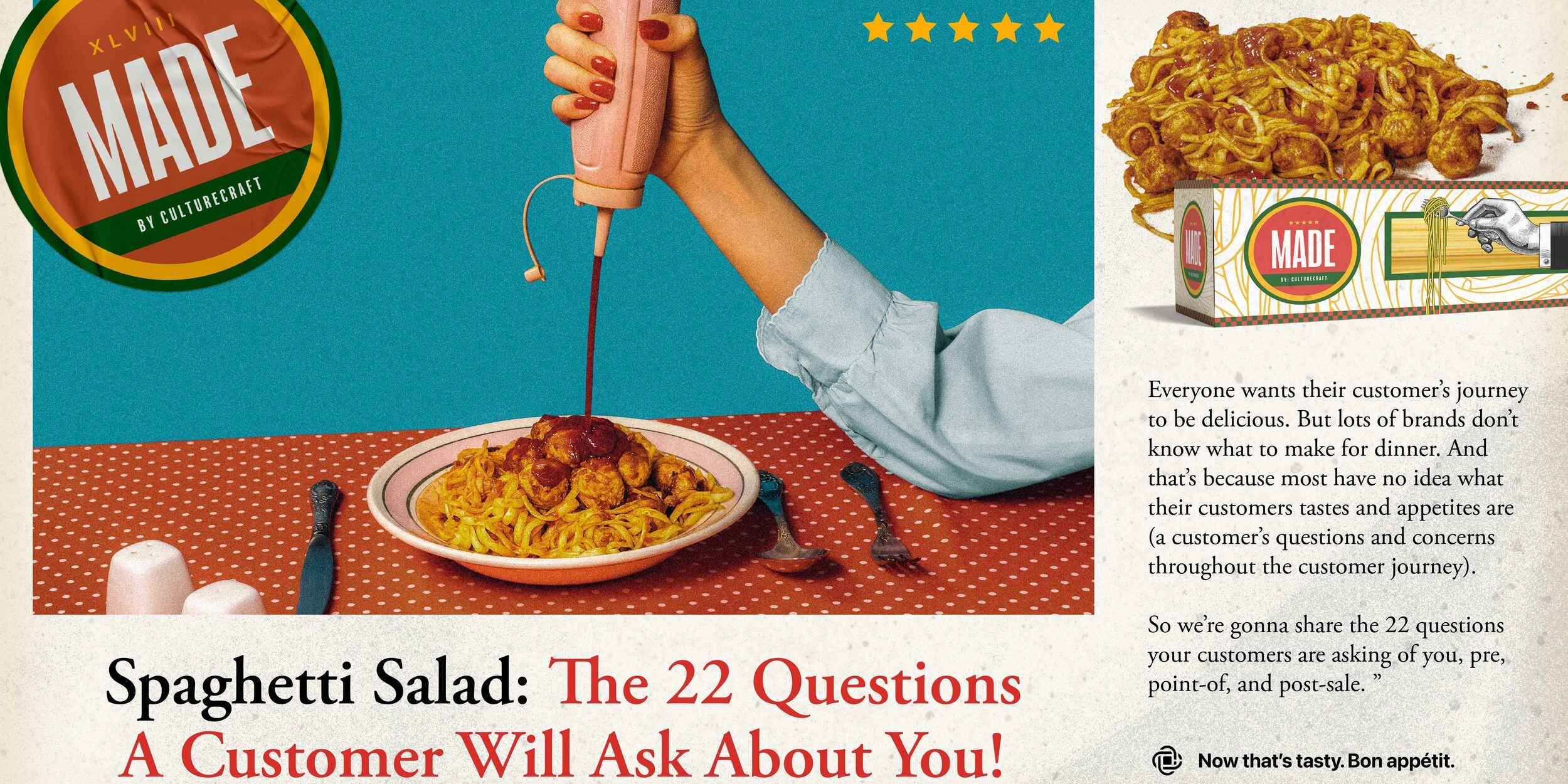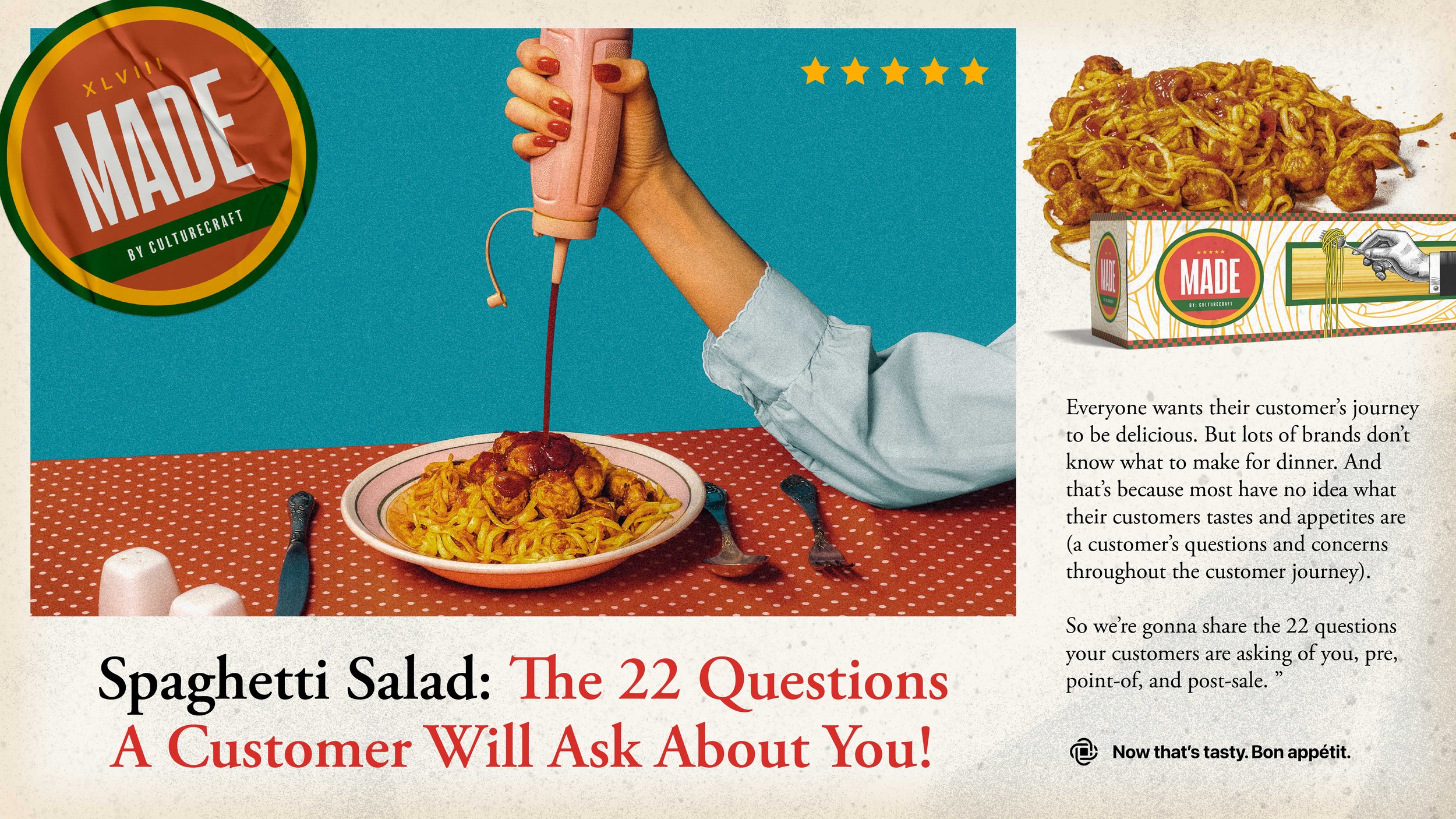In our most hopeful of hearts, we want customer journeys to look like straight lines. Predictable, plannable, easily understood straight lines.
If customer journeys were in straight lines then we would know what a customer needs each step of the way, feed them the required data, content, opportunity, CTA, or whatever, and collect their money on cue, right?
The problem is that customer journeys might be charted like straight lines, but the actual thing meanders like spaghetti salad – interconnected, multilayered, with very little respect for directional “flow”.
Customers may get a big buying question answered like, “What are your features?” only to immediately about-face and return to the top of the funnel in search of something else.
That’s why the best customer journeys, must include time and elements that help answer customer questions along the way. Like a great dinner party, there should be a wonderful structure so customers can savor the appetizers (pre-sale), enjoy a great menu (at-sale), and take the leftovers home (post-sale).
But, also like a great dinner party, we mustn’t be so focused on the itinerary that we assume someone won’t spot the dessert straight away and ask for a taste. Or want to revisit the appetizer before the espresso has been poured.
Customer journeys, like appetites, are unpredictable.
The upside of a customer journey that’s built to accommodate both the linear and non-linear buyer, is that it’s laden with value – since you never know where a customer might double down or back in curiosity and buying intent.
The driving forces behind every customer journey are questions, specifically, questions your customer will ask at different stages of the journey. If you know the questions, you can craft the stages of the customer journey as a series of answers, helping to add value each step of the way.
So, to give you a hand at building out that killer dinner party, below are 22 questions consumers will ask during their customer journey.
Planning the party
Naturally, when someone first encounters your brand or product, they’ll start trying to answer some questions. Here are a few of them:
1. Do you know me? – Customers want to know that your brand\product is actually for them, made with them in mind, and ready to care for them.
2. Do you know what my problem is? – This gets answered by your product, but also by your content, brand positioning, and more.
3. Do you have a solution? – Here’s where clarity of product really matters.
4. What are the product’s features? – Everyone will want to know.
5. Is that solution ACTUALLY for me? – Customers need reassurance. If they’re looking for a suit, they want to see pictures of that suit on someone that looks like them, at an event they might be going to.
6. Do you have more than one solution? – Sometimes options are optimal, sometimes the enemy. Knowing your audience dictates the answer.
7. What are others saying about your brand\solutions? This is not just gauged on your website. There will be searches and inquiries made elsewhere. This is where brand reputation matters immensely.
8. Are there clear next steps? – It may take a prospect 5 minutes or 5 months to arrive at this question – either way, you want to make sure there’s an answer and the answer is yes.
9. Are you sure this is going to work? – Remember what we said about customers needing reassurance?
The standouts in this early phase are helping to make sure that your customers feel welcomed, wanted, and clear that your brand and your products are truly for them.
Nearing point-of-sale, there should be no question about whether or not the brand and product are for the customer. That part of the journey should be complete. Now that you’ve warmed the customer’s appetite, we move on to the main courses. Some questions in this area of the journey:
10. Will you engage with me the way I want to be engaged? – Customers want buying options. Is it possible to pay with Apple Pay? Is there a payment or installment plan?
11. How flexible are you? – This question is especially well answered by companies like Eddie Bauer, Patagonia, and others with a lifetime return policy and a plethora of return\reuse programs.
12. How often do I get what I want? – Clarity is again key: is this purchase one-time, reoccurring, subscription service, etc.
13. What do you need from me? – Trading content for information? Need card info? Other details?
14. Will you make this easy? – The system for checking out should feel streamlined and quick – this is not the time to keep selling to the customer.
During the point-of-sale part of the customer journey, there must be proper reassurance that they are indeed making the right decision. The way to achieve that reassurance is to make the process of buying quick, easy, flexible, and not a time to be sold additional products.
Boxing Up The Leftovers
There are plenty of brands out there that ace the first two sections of the customer journey, only to fall flat at, what is possibly, the most important part of the journey: post-purchase.
Some questions your brand has to be able to answer in the post-purchase:
15. What if change my mind or there’s a problem with the product? – It’s inevitable that from time to time something will go wrong with the product or service you provide. The brand’s timely, gracious, and generous response to this problem will dictate the impact to your brand’s reputation.
16. Will you honor our agreement? – Ever signed up for a product or service only to have the provider increase your rates later on down the line, seemingly out of the blue? Yeah, don’t be like that.
17. Is it what I wanted? – Rarely up to you and will be asked of your product or service.
18. It is what you promised? – Totally up to you, and will be asked of your product or service
19. Does it give me ongoing value? – Very few products are one-use. But even if yours is, the memory of using that product or service should be held fondly and with a desire to repeat it.
20. Will you help me if I need it later? – Too many brands have a taillight warranty (where they’ll help up till the moment they see your taillights driving away.) Being available to your customers shouldn’t end once they’ve made their purchase. They should feel you’re ready to help whenever the opportunity arises.
21. Do you have more to offer? – The dream question for every brand, the answer is always YES.
22. Are you going to email me to death? – Customers want to know you’re available to help. But they don’t want to be blitzed to death by sales pitches in their emails. Nothing makes a customer or client feel less like a person than an automated 30% off limited-time offer for the fifth straight week in a row in their inbox.
See You Soon
There they are – 22 questions. You could probably think of a few more if you tried hard enough, and if you do, add them to the list. The more questions you’re prepared to proactively meet with answers, the better.
But just remember, as we mentioned at the top, the journey your customers go on will rarely be as linear as the list above. Some customers will ask every single question, some will ask three. Others still will ask a question, forget the answer, and ask it again a week later.
The customer journey’s job is not to judge, but to provide value each step of the way, so as to produce unwavering confidence in the customer that the purchase they’re making is the right one. A great customer journey, no matter how spaghetti salad-ish it looks, leads to a sale.
And as the great advertising thinker, Rosser Reeves once wrote, “For a sale is regenerative; it is a chain reaction that spawns profits year after year as the customer returns again and again to buy more and more.”
A journey indeed.
We know getting the answers to all 22 of these questions can feel tough. And how exactly do you create value at each step of the way?
These kinds of worries can flatline a brand. But they don’t have to flatline yours.
Whether you need consultative work to get your brand’s strategies aligned and healthy, or new creative to boost the appeal, reach, and reputation of your brand, CultureCraft is here to help.
And now can take 15% off our client-onboarding Brand Audit, (which gives you a deeply insightful and actionable look at your brand’s current health and posture) when you book a call before June 15th.
15% off before the 15th. Delicious.
Till then, bon appetit.




